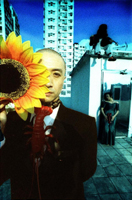|
'1, 2, 3, 4, 5, 6; 2, 2, 3, 4, 5, 6...' counted Kung Chi-shing in the rehearsal room. Mui Cheuk-yin and Xing Liang repeated their movements again and again to synchronize their bodies with the rhythm of the music.
'I want to take some elements from the paintings and turn them into dance,' said Mui Cheuk-yin. Picture frames of different sizes will also be hung on stage, suggesting that they are painting moving pictures.
Salvador Dalí was renowned as a master of Surrealist art. In his paintings that go beyond reality, distorted figures and objects manifest subconscious desires. But why Dalí but not Picasso or other modern artists? What was it that they found most appealing in Dalí? Mui's eyes gleamed. She said, 'The erotic!' What is most often suppressed by reason is dark desire. Actually, it was Xing Liang who first suggested doing a piece about Dalí, since he had always been attracted by the alogical yet seemingly plausible world in Dalí's work.
If the distorted faces, ants, watches or lobster phones are Dalí's trademark, his wife Gala is no doubt the eternal goddess haunting his work. Asked why they wanted to create a dance work about Dalí and Gala, Mui said, 'The relationship between Dalí and Gala was actually quite enigmatic. While many people study Dalí's art, his emotional life is not much known.' Some say Dalí was impotent, while others claim he was homosexual. Mui went on to say, 'But at least from Dalí's work, we can see how much he adored Gala. She was frequently featured in his paintings, but often with her back towards viewers or otherwise full of mystery.' Gala is present in some 60 among Dalí's approximately 1,600 paintings. Apart from her portraits, even her feet, the ceiling of her house and her castle were depicted by Dalí. If this was not amour fou, it was certainly an obsession and a preoccupation with Gala.
In his old age, Dalí returned to his birthplace Figueres to found his own museum Teatro Museo. His aim was to transcend the picture frame and turn a museum into a theatre. Now, in The Enigma of Desire – Dalí vs. Gala, starting off from Dalí's paintings, Xing and Mui will go on to explore his relationship with Gala, and further the relationships between men and women in general nowadays. Through their bodies and Kung Chi-shing's music, petty lovers' quarrels, the battle of the sexes or the anxiety of men losing power will be enacted at the Fringe studio theatre.
For now, Kung played the music he arranged again. '1, 2, 3, 4, 5, 6...' Xing and Mui again danced to the beats, exploring the harmony between their bodies, the space and the music. In between the moment of inertia and re-action, they explore the asymmetric desires revealed in Dalí's Surrealism of the erotic and his ineffable affections for Gala. |
|
|
» published in CCDC Dance Season 2003 magazine(04.2003)
by: © 魂游 wen yau 2003 |
| photo: © City Contemporary Dance Company |

